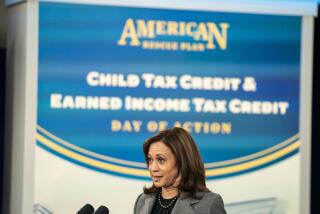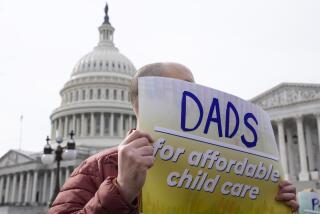On the Cutting Edge : Poor Fear Welfare-Reform Actâs Cuts to Day-Care, Nutrition Funding
Her break from welfare came three years ago, when a government subsidy for child care enabled her to find part-time work, enroll in vocational school and finally envision independence.
But the North Hollywood womanâs hopes could vanish in a heartbeat because of proposed budget cuts pending before the new, Republican-controlled Congress. Under its sweeping welfare-reform plan, she could lose not only the partial Aid to Families with Dependent Children (AFDC) that helps cover her living expenses but the day-care subsidy underlying her studies for a career in nursing.
âIf I couldnât have gotten the subsidy I donât know what I would be doing,â said the 27-year-old mother of two, who has been on welfare for five years and spoke on condition of anonymity. âI might be still stuck on AFDC or, worse, not have gone to school.â
Indeed, as she and many experts contend, child care is the linchpin of the GOPâs proposed welfare-reform act, which boasts an âend to welfare as we know itâ by compelling parents to find work after two years on aid.
But part of the measure includes deep cuts to day care and nutrition funding programs, which advocates for poor and low-income families also say could ultimately undermine efforts to get welfare mothers to work, as well as making the lives of already-working parents even harder.
In the San Fernando Valley, for instance, one affected group is expected to be the significant--though undetermined--number of parents who bring their children to so-called family day-care centers, the small programs operated in private residences licensed to serve no more than a dozen children.
Not only might federally funded meals be eliminated at the popular family day-care centers, but low- and moderate-income working families could lose the government subsidies that help cover their child-care costs. An estimated 178,000 children are enrolled in both large and small licensed child-care programs throughout Los Angeles County, with 15,000, or 8.5%, of them using government funding to help pay for the assistance.
âFamilies with two or three kids who are making $25,000 a year are eligible for the (child-care) subsidy and need that assistance to allow them to hold down a job to keep them off welfare,â said Laura Escobedo, associate director of the Child Care Resource Center in North Hollywood.
Reliable day care is the trickiest part of the welfare-reform plan, because it is both expensive and in short supply, Escobedo said. Average annual costs range from $3,900 to $6,900 per child, and many licensed, high-quality programs are not open during the odd hours typical of the entry-level jobs that former welfare recipients often land.
The GOP measure, approved by the House in March, would reduce available child care even further by offering no new funding at a time when thousands of parents will be entering the work force, child-care advocates say. The proposed changes could mean an additional 2 million children nationwide in need of child care by 2000 if their parents are forced to work, according to the Childrenâs Defense Fund, a Washington-based childrenâs advocacy organization.
*
One grim prediction is that poor families already struggling to remain intact would only find themselves under more financial stress as their day-care expenses rise, which in turn would trigger a chain reaction of neglect or abuse and land more children in an already overburdened foster-care system.
âFrustration translates into aggression,â said Peter Digre, director of the county Department of Children and Family Services. As unemployment rose during Southern Californiaâs recession, he said, âso did the number of reported child abuse and neglect cases.â
Desperation can also set up some dangerous situations. Too often, social workers say, parents anxious to work but without professional child care leave their grade-school children in charge of toddlers. Or they will bring the kids to work and risk losing their jobs.
âI have cousins and theyâre on AFDC and they want to do something and they canât afford child care,â the North Hollywood mother said. âAnd they look at me like Iâve got some million-dollar lottery ticket, because Iâm getting help to pay for my child care.â
Child care was also the key to Irene Brennickâs success. The single mother of two stopped getting welfare checks and started working full time in August.
Now a fund-raiser for United Way, Brennick sings praises to the Child Care Resource Center and the financial help it gave her to cover her day-care fees during the five years she attended Cal State Northridge. Brennick, who graduated with honors, majored in fund raising so she could help nonprofit groups such as the one that helped her.
âAs soon as I had day care, I had my life back,â Brennick said. âI had energy. I had hope. I finally had an opportunity to do something with myself again.â
Brennick still receives partial child-care assistance, but is working her way off the program.
But under the GOPâs welfare-reform package, now being weighed by the Senate, Brennick and other mothers would find far less support.
In its attempt to consolidate programs and save money, the five-year plan would cut funding for child care and nutrition programs by about $9 billion and would freeze the level of funding for child-care grants until 2000, according to the U. S. Department of Health and Human Services.
Programs that provide free meals at day-care centers would have to compete for funding with other nutrition services, including the Homeless Preschool Program for homeless children and the Women Infant Children (WIC) nutrition program for impoverished pregnant mothers and their children.
The proposed cuts also would eliminate current health and safety regulations for day-care providers, requirements that states match federal funding for child-care assistance, and an existing guarantee of a year of subsidized child care for parents in transition between welfare and job-training programs.
âThey took 10 completely different federal programs and lumped them all together with the same eligibility cap, so when the numbers (of needy families) go up thereâs no rise in funding and this leaves some families with nothing,â said Alice Walker-Duff, executive director of Crystal Stairs, a Los-Angeles based agency that sponsors 2,500 day-care providers serving more than 15,000 children.
If the House-approved measure goes through the Senate unchanged, Walker-Duff said 10,000 children could be cut from her agencyâs food program.
The U. S. Department of Health and Human Services estimates that under the GOP proposal more than 370,000 children nationwide would lose child-care assistance by 2000. About 3,000 subsidized child-care spots in day-care centers would be lost in Los Angeles County.
*
Low-income families and welfare recipients would be clamoring for the same pool of diminishing funds, experts say. Those not on welfare would most likely be the losers.
âIf thereâs gonna be this big push to get people off welfare, theyâre going to have first priority for the (child care) subsidy and the people who are just off welfare or the working poor are not going to have access to the subsidy, so theyâre going to end up back on welfare,â said Karen Malaske-Samu, child-care coordinator for Los Angeles County.
Budget cuts to child-care nutrition programs could also stymie welfare-reform plans, local social workers and day-care providers say.
The food programs are the incentive for some baby-sitters to become licensed day-care providers and be permitted to care for more children. Children enrolled in centers with the program receive 75% of their nutritional needs through those meals, said Barbara Reisman, executive director of the Child Care Action Campaign in New York.
Even for parents who pay for their own child care, the breakfast and lunches served at family day-care centers are vital assurances that their children are eating at least one or two balanced meals a day. Not having to prepare those meals also saves working parents precious time and money.
âSometimes when parents are in a hurry, they rush to McDonaldâs and give that to their child for lunch and when you heat it up, itâs disgusting. So I would make food for them anyway,â said Rosa Gonzales, who runs a family day-care center in Arleta.
Gonzales has been receiving about $500 a month since December, 1993, to feed her two sons and the 11 children she cares for daily with hot meals such as spaghetti or quesadillas with vegetables. Sometimes she uses her own money to cover the added costs of buying watermelon, mangoes or strawberries--healthy treats the children love.
Under current law, any child, regardless of family income, can take advantage of the free meals. But the proposed GOP measure requires parents to prove they are low income and in need of the free meals.
In California, state officials said many of the more than 30,000 licensed, family child-care programs that serve meals would probably stop doing so. In Los Angeles County, that could mean that a substantial chunk of the 4,000 licensed, family day-care centers would be affected, forcing many children to come with their own meals, Malaske-Samu said.
For Margarita Almada of Arleta, the change would mean either sending bagged lunches with her two children or paying Gonzales more money. Either way, it would deplete the $240 weekly salary Almada makes answering phones at a Van Nuys electronics parts store. A single mother, Almada and her 2 1/2-year-old daughter live with Almadaâs mother to make ends meet.
The pending changes in the food program could also affect Gonzalesâ business. She already charges a low weekly fee of $75 for toddlers when the average rate is $90. But she would have to raise her prices if parents donât want to provide lunches. That could mean a loss of clients.
For other family day-care providers, it could mean the end of business.
âSome people may lose so many children they might just decide that itâs not worth it,â Escobedo of the Child Care Resource Center said. âWeâre expecting that to happen.â
Escobedo and other child-care advocates say Washington lawmakers donât understand the impact their cuts are going to have.
âWeâve come so far and whatâs happening in Washington can reverse things so strongly and negatively,â Escobedo said. âItâs going to be a smaller boat with more people in it and what weâre afraid of is that people are going to fall off and drown.â
More to Read
Get the L.A. Times Politics newsletter
Deeply reported insights into legislation, politics and policy from Sacramento, Washington and beyond. In your inbox three times per week.
You may occasionally receive promotional content from the Los Angeles Times.










